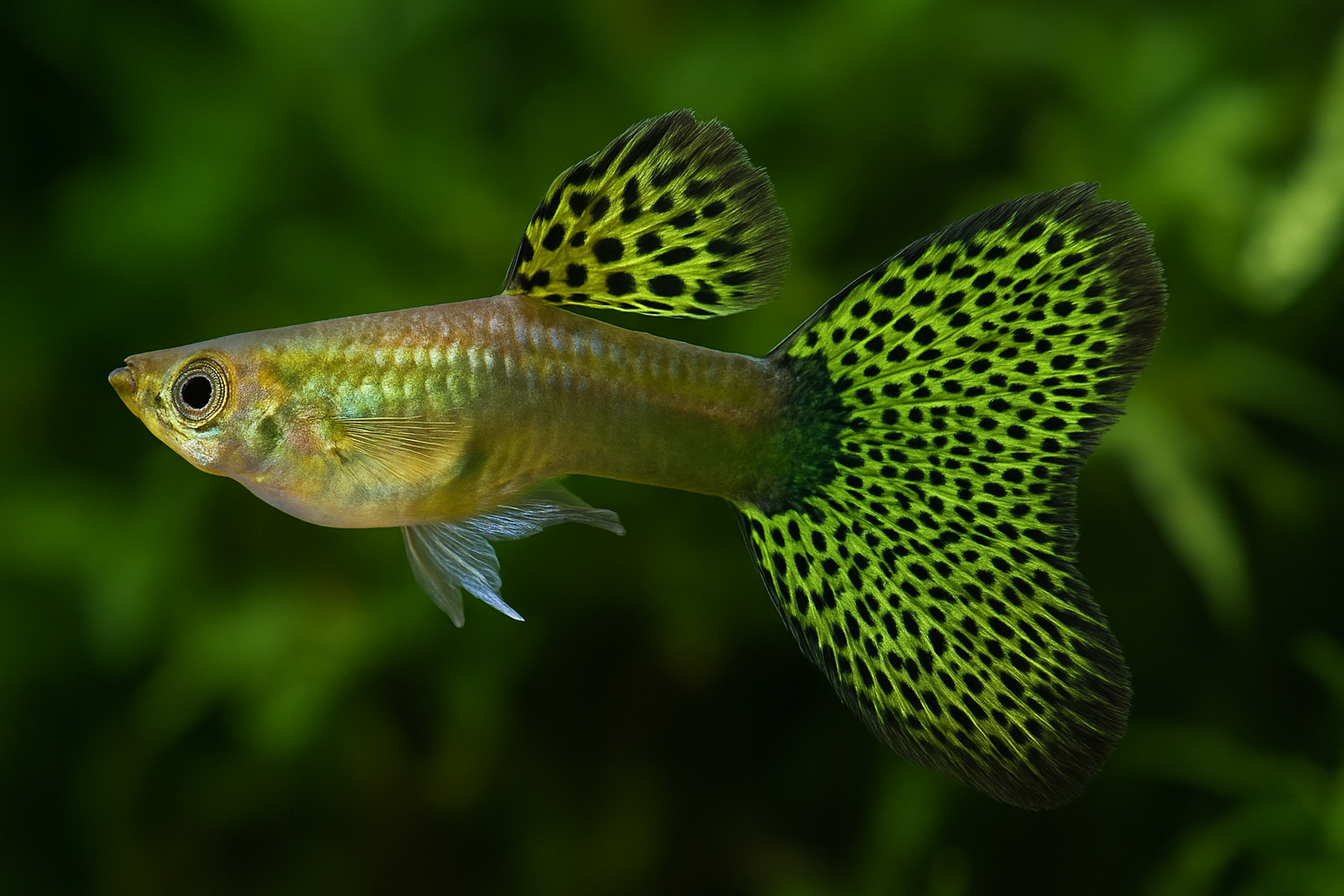The Green Grass Guppy is a stunning and elegant guppy strain that features a mesmerizing green hue paired with intricate, grass-like patterns across its tail and fins. This strain stands out in any aquarium, offering not only visual appeal but also the characteristic hardiness and sociable nature that guppies are known for.
As a variant of Poecilia reticulata, the Green Grass Guppy has been selectively bred for its beautiful coloration and patterning. Ideal for both novice and experienced aquarists, these guppies are peaceful, active, and simple to breed—making them an excellent addition to freshwater tanks.
In this comprehensive guide, you’ll learn everything about the Green Grass Guppy—from its appearance and ideal tank setup to feeding habits, breeding process, and common care tips. Whether you’re a hobbyist or a professional aquarist, this guide will help you successfully keep and enjoy this remarkable guppy strain.
Overview and Appearance
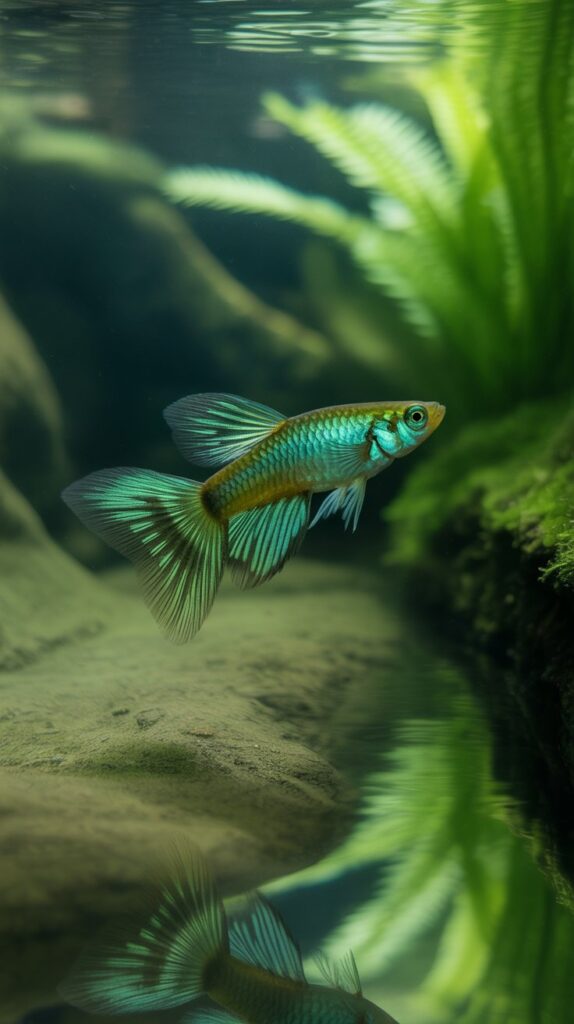
Key Features:
- Color: Bright to deep green hues with a flowing grass-like tail pattern.
- Fins: Transparent base with interwoven green streaks that mimic blades of grass.
- Males vs Females:
- Males: Smaller, slimmer, more vibrant coloration and longer tails.
- Females: Larger body, rounder belly, and subdued coloring.
Size:
- Males: 1.2–1.5 inches
- Females: 2–2.4 inches
Lifespan:
- Typically 2 to 3 years, though proper care can sometimes extend it.
Behavior:
- Extremely peaceful, social, and active swimmers.
- Perfect for community aquariums with other non-aggressive species.
Ideal Tank Setup for Green Grass Guppies
To thrive, Green Grass Guppies require a well-maintained and stable environment. Let’s explore the optimal tank conditions.
Tank Size:
- A minimum of 10 gallons for a small group.
- 20+ gallons preferred for larger communities or breeding colonies.
Water Parameters:
- Temperature: 74°F to 82°F (23°C to 28°C)
- pH: 6.8 to 7.8
- Hardness: 8–12 dGH
- Ammonia/Nitrite: 0 ppm
- Nitrate: < 20 ppm
Filtration and Aeration:
- Use a gentle sponge filter or low-flow HOB filter.
- Guppies dislike strong currents; ensure smooth water movement.
- An air stone may be used to enhance oxygenation.
Substrate and Decorations:
- Use dark-colored gravel or sand to make green colors pop.
- Decorate with aquatic plants, driftwood, and rocks to simulate a natural habitat.
- Provide hiding spots to reduce stress, especially for females and fry.
Lighting:
- Moderate to high lighting enhances green coloration and supports plant growth.
- Keep lighting on for 8–10 hours a day.
Tank Mates for Green Grass Guppy
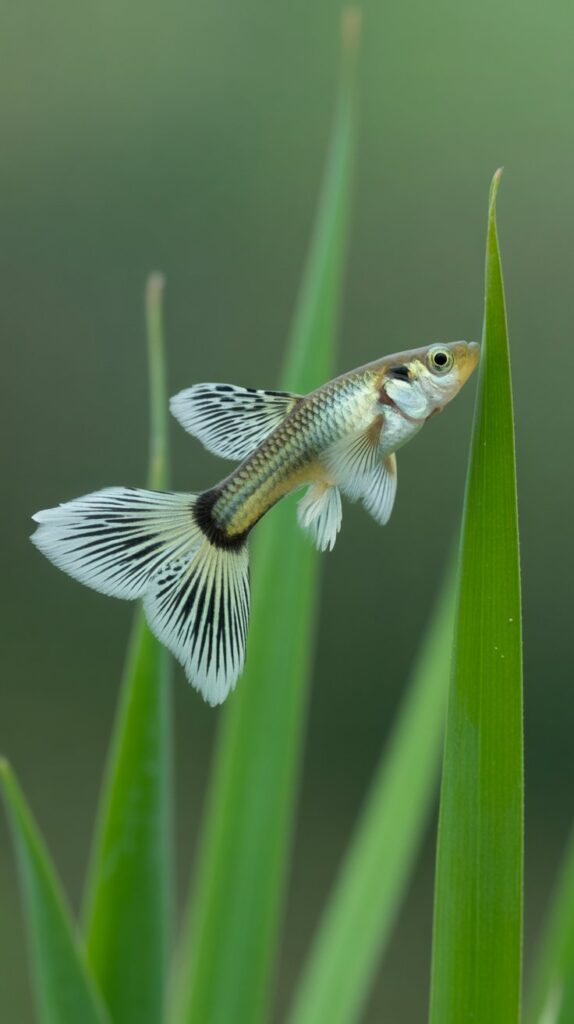
Green Grass Guppies are very peaceful and sociable, making them ideal tank mates for other non-aggressive species. Some good choices include:
Compatible Tank Mates:
- Other guppy varieties
- Mollies
- Platies
- Neon Tetras
- Corydoras catfish
- Cherry shrimp
- Mystery or Nerite snails
Avoid:
- Fin-nippers (e.g., tiger barbs)
- Aggressive fish (e.g., cichlids)
- Large predatory fish
Diet and Feeding
A nutritious and varied diet ensures your Green Grass Guppies maintain their vibrant coloration and health.
What to Feed:
- Flake food (high-quality, color-enhancing formulas)
- Live food: brine shrimp, daphnia, mosquito larvae
- Frozen food: bloodworms, tubifex
- Vegetables: blanched spinach, zucchini, or peas
Feeding Tips:
- Feed 2–3 small meals per day.
- Remove uneaten food after 2 minutes to avoid water pollution.
- Supplement their diet with spirulina-based food to enhance the green pigmentation.
Breeding Green Grass Guppies
Breeding Green Grass Guppies is easy and rewarding. They are livebearers, meaning they give birth to free-swimming fry.
Mating and Gestation:
- Males chase females constantly for mating.
- Keep 1 male per 2–3 females to prevent stress.
- Gestation period is around 21–30 days.
Signs of Pregnancy:
- Enlarged abdomen
- Darkened gravid spot near the anal fin
- Lethargy and hiding behavior near birth
Fry Care:
- Separate fry from adults using a breeding box or dedicated nursery tank.
- Feed fry with baby brine shrimp, powdered fry food, or micro worms.
- Ensure dense plant coverage to provide hiding spots if fry are left in the main tank.
Growth Rate:
- Fry grow rapidly in their first month.
- Gender differences become noticeable by 4–6 weeks.
Common Diseases and Prevention
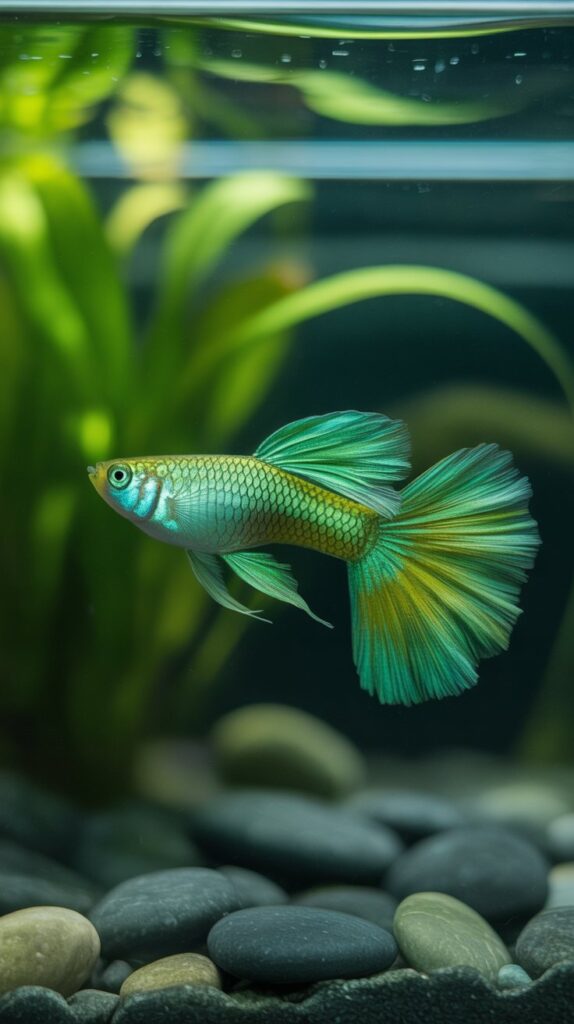
Although hardy, Green Grass Guppies can fall prey to common freshwater fish ailments, especially if tank conditions are poor.
Common Diseases:
- Ich (White Spot Disease):
- Symptoms: Small white dots, rubbing against surfaces
- Treatment: Increase temperature slightly + Ich medication
- Fin Rot:
- Symptoms: Ragged fins, discoloration
- Treatment: Antibacterial treatments + improved water quality
- Velvet Disease:
- Symptoms: Gold/brown dusty coating
- Treatment: Copper-based medications
- Swim Bladder Disorder:
- Symptoms: Floating or sinking uncontrollably
- Causes: Overfeeding or constipation
- Treatment: Fasting + feeding shelled peas
Prevention Tips:
- Maintain stable water conditions
- Perform weekly water changes (25–30%)
- Quarantine new fish for at least 2 weeks
- Avoid overfeeding and overcrowding
Enhancing Color in Green Grass Guppies
To keep your Green Grass Guppies looking their best:
- Feed a balanced and color-enhancing diet
- Maintain pristine water quality
- Use dark substrates and live plants to highlight their green hues
- Provide adequate tank lighting
- Avoid stress and overcrowding
Benefits of Keeping Green Grass Guppies
Here are several reasons why the Green Grass Guppy is a perfect addition to your aquarium:
- Striking visual appeal
- Peaceful nature makes them great community fish
- Low maintenance and beginner-friendly
- Rapid breeders, perfect for hobbyist projects
- Adaptable to a wide range of tank environments
Aquascaping for Green Grass Guppies
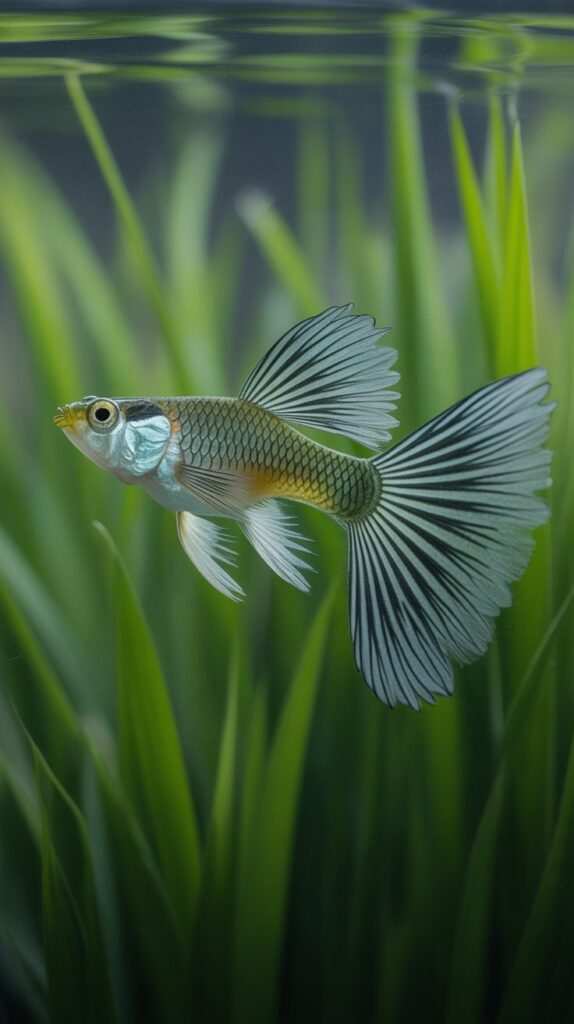
Green Grass Guppies shine brightest in well-planted tanks. Here are a few tips:
Recommended Plants:
- Guppy Grass
- Java Fern
- Hornwort
- Amazon Sword
- Water Sprite
Benefits of Live Plants:
- Natural biological filtration
- Hiding spots for fry and shy fish
- Algae control and oxygenation
- Enhances fish coloration
Where to Buy Green Grass Guppies
Green Grass Guppies are available at:
- Local fish stores
- Online aquarium retailers
- Aquatic trade shows
- Reputable breeders and hobbyist groups
What to Look For:
- Bright, consistent green coloration
- Active swimming behavior
- Clear eyes and intact fins
- No signs of parasites or infections
Tips for Long-Term Success
- Always cycle your aquarium before adding fish.
- Keep a consistent maintenance schedule.
- Observe fish daily for behavioral changes.
- Don’t mix too many aggressive or fin-nipping species.
- Use a lid or cover—guppies are known to jump!
Conclusion
The Green Grass Guppy is more than just a beautiful fish—it’s a peaceful, active, and rewarding species that thrives with the right care. Whether you’re new to the hobby or an experienced aquarist, these guppies add vibrancy, movement, and life to your aquarium.
Their ease of care, breeding potential, and compatibility with a wide variety of tank mates make them a valuable addition to any freshwater setup. With proper care, you’ll enjoy a thriving community of shimmering green guppies for years to come.
FAQs About Green Grass Guppies
Q1: What is the lifespan of a Green Grass Guppy?
A: They usually live 2–3 years with proper care and optimal tank conditions.
Q2: How can I tell male and female Green Grass Guppies apart?
A: Males are smaller and more colorful with longer fins, while females are larger with a rounded belly and less vibrant colors.
Q3: Do Green Grass Guppies eat their fry?
A: Yes, adult guppies often eat fry. It’s best to separate fry or provide lots of hiding spots.
Q4: What is the ideal water temperature for Green Grass Guppies?
A: Between 74°F and 82°F (23–28°C).
Q5: Can I keep Green Grass Guppies in a bowl?
A: No. Guppies need a filtered, heated tank of at least 10 gallons.
Q6: What should I feed my Green Grass Guppies?
A: A mix of flake food, live or frozen protein, and occasional veggies like peas or zucchini.
Q7: Are Green Grass Guppies good for beginners?
A: Yes, they’re easy to care for and ideal for beginners due to their hardiness.
Q8: Can I keep Green Grass Guppies with shrimp?
A: Yes! Cherry shrimp or Amano shrimp are great tank mates.
Q9: How often should I change the water in my guppy tank?
A: Weekly water changes of 25–30% are ideal.
Q10: Do Green Grass Guppies require live plants?
A: Not required but highly recommended for better health, aesthetics, and fry protection.

